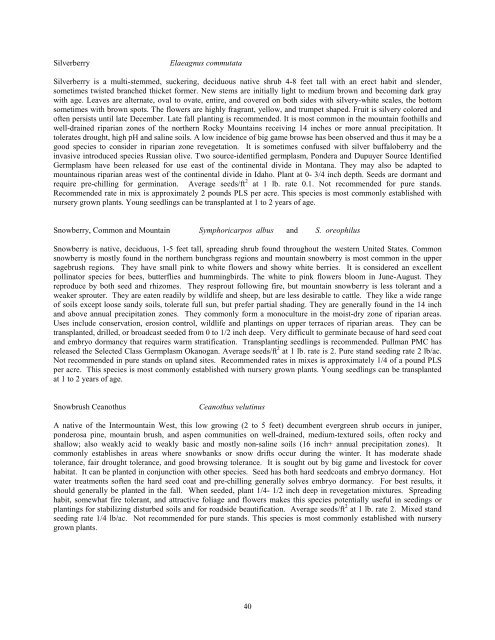Idaho Plant Materials Technical Note No. 24
Idaho Plant Materials Technical Note No. 24
Idaho Plant Materials Technical Note No. 24
You also want an ePaper? Increase the reach of your titles
YUMPU automatically turns print PDFs into web optimized ePapers that Google loves.
Silverberry<br />
Elaeagnus commutata<br />
Silverberry is a multi-stemmed, suckering, deciduous native shrub 4-8 feet tall with an erect habit and slender,<br />
sometimes twisted branched thicket former. New stems are initially light to medium brown and becoming dark gray<br />
with age. Leaves are alternate, oval to ovate, entire, and covered on both sides with silvery-white scales, the bottom<br />
sometimes with brown spots. The flowers are highly fragrant, yellow, and trumpet shaped. Fruit is silvery colored and<br />
often persists until late December. Late fall planting is recommended. It is most common in the mountain foothills and<br />
well-drained riparian zones of the northern Rocky Mountains receiving 14 inches or more annual precipitation. It<br />
tolerates drought, high pH and saline soils. A low incidence of big game browse has been observed and thus it may be a<br />
good species to consider in riparian zone revegetation. It is sometimes confused with silver buffaloberry and the<br />
invasive introduced species Russian olive. Two source-identified germplasm, Pondera and Dupuyer Source Identified<br />
Germplasm have been released for use east of the continental divide in Montana. They may also be adapted to<br />
mountainous riparian areas west of the continental divide in <strong>Idaho</strong>. <strong>Plant</strong> at 0- 3/4 inch depth. Seeds are dormant and<br />
require pre-chilling for germination. Average seeds/ft 2 at 1 lb. rate 0.1. <strong>No</strong>t recommended for pure stands.<br />
Recommended rate in mix is approximately 2 pounds PLS per acre. This species is most commonly established with<br />
nursery grown plants. Young seedlings can be transplanted at 1 to 2 years of age.<br />
Snowberry, Common and Mountain Symphoricarpos albus and S. oreophilus<br />
Snowberry is native, deciduous, 1-5 feet tall, spreading shrub found throughout the western United States. Common<br />
snowberry is mostly found in the northern bunchgrass regions and mountain snowberry is most common in the upper<br />
sagebrush regions. They have small pink to white flowers and showy white berries. It is considered an excellent<br />
pollinator species for bees, butterflies and hummingbirds. The white to pink flowers bloom in June-August. They<br />
reproduce by both seed and rhizomes. They resprout following fire, but mountain snowberry is less tolerant and a<br />
weaker sprouter. They are eaten readily by wildlife and sheep, but are less desirable to cattle. They like a wide range<br />
of soils except loose sandy soils, tolerate full sun, but prefer partial shading. They are generally found in the 14 inch<br />
and above annual precipitation zones. They commonly form a monoculture in the moist-dry zone of riparian areas.<br />
Uses include conservation, erosion control, wildlife and plantings on upper terraces of riparian areas. They can be<br />
transplanted, drilled, or broadcast seeded from 0 to 1/2 inch deep. Very difficult to germinate because of hard seed coat<br />
and embryo dormancy that requires warm stratification. Transplanting seedlings is recommended. Pullman PMC has<br />
released the Selected Class Germplasm Okanogan. Average seeds/ft 2 at 1 lb. rate is 2. Pure stand seeding rate 2 lb/ac.<br />
<strong>No</strong>t recommended in pure stands on upland sites. Recommended rates in mixes is approximately 1/4 of a pound PLS<br />
per acre. This species is most commonly established with nursery grown plants. Young seedlings can be transplanted<br />
at 1 to 2 years of age.<br />
Snowbrush Ceanothus<br />
Ceanothus velutinus<br />
A native of the Intermountain West, this low growing (2 to 5 feet) decumbent evergreen shrub occurs in juniper,<br />
ponderosa pine, mountain brush, and aspen communities on well-drained, medium-textured soils, often rocky and<br />
shallow; also weakly acid to weakly basic and mostly non-saline soils (16 inch+ annual precipitation zones). It<br />
commonly establishes in areas where snowbanks or snow drifts occur during the winter. It has moderate shade<br />
tolerance, fair drought tolerance, and good browsing tolerance. It is sought out by big game and livestock for cover<br />
habitat. It can be planted in conjunction with other species. Seed has both hard seedcoats and embryo dormancy. Hot<br />
water treatments soften the hard seed coat and pre-chilling generally solves embryo dormancy. For best results, it<br />
should generally be planted in the fall. When seeded, plant 1/4- 1/2 inch deep in revegetation mixtures. Spreading<br />
habit, somewhat fire tolerant, and attractive foliage and flowers makes this species potentially useful in seedings or<br />
plantings for stabilizing disturbed soils and for roadside beautification. Average seeds/ft 2 at 1 lb. rate 2. Mixed stand<br />
seeding rate 1/4 lb/ac. <strong>No</strong>t recommended for pure stands. This species is most commonly established with nursery<br />
grown plants.<br />
40
















